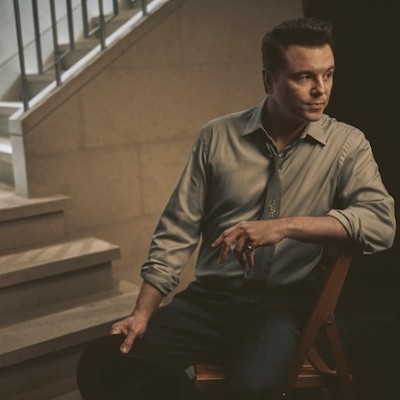Dec 9, 2025 12:28 PM
In Memoriam: Gordon Goodwin, 1954–2025
Gordon Goodwin, an award-winning saxophonist, pianist, bandleader, composer and arranger, died Dec. 8 in Los Angeles.…
Bebo Valdés at New York’s Village Vanguard in 2005 (Photo: © Jack Vartoogian/FrontRowPhotos)
(Photo: )Pianist, composer and bandleader Bebo Valdés died on March 22 in Stockholm at age 94. He had suffered from pneumonia and Alzheimer’s disease.
A legendary figure in the history of Cuban music, Valdés is credited with developing the batanga rhythm. His lengthy career included a 1948–’57 stint as the house pianist at Havana’s famous Tropicana Club, as well as an artistic resurgence that began in the 1990s and eventually earned him three Grammy awards and six Latin Grammy awards.
Valdés’ global popularity was enhanced by his association with a number of critically acclaimed films in the 21st century. He appeared in Fernando Trueba’s 2000 documentary on Latin jazz, Calle 54, and he was the subject of Carlos Carcas’ 2008 documentary, Old Man Bebo. Valdés’ life in Cuba was a key inspiration for the 2010 animated film Chico & Rita. In one of his final recording sessions, Valdés composed and recorded music for that film, which earned an Oscar nomination for best animated feature.
Ramón Emilio Dionisio Valdés Amaro was born on Oct. 9, 1918, in Quivicán, Cuba. He studied classical piano at Havana’s Conservatorio Municipal and later worked as a pianist and arranger for Mil Diez, a radio station that presented live music. Valdés became the music director for bandleader Julio Cueva, who had a hit in 1945 with the mambo tune “La Rareza Del Siglo (The Strangeness Of The Century).”
In 1948, singer Rita Montaner hired Valdés to be her pianist and arranger for performances at the Tropicana, and he later continued working there. Valdés performed with many U.S. jazz stars who visited the club, such as Woody Herman, and he wrote the arrangements for Nat “King” Cole’s Spanish-language album Cole Español, recorded mostly in Havana in 1958.
Valdés founded his own orchestra, Sabor de Cuba, in 1959. That same year he had a big hit with “Sabor A Mí,” which was recorded with vocalist Rolando Laserie.
After Fidel Castro gained power in 1959, Valdés decided to leave Cuba. He departed in 1960 and never returned, choosing to spend time in the United States, Mexico, Spain and Switzerland. While on tour, he met Rose Marie Pehrson—the Swedish woman who would become his second wife—and moved to Stockholm in 1963. He became a Swedish citizen and remained married to Rose Marie until her death in 2012.
Valdés spent decades playing in Stockholm hotel lounges and then retired. But he was coaxed out of retirement by reedist Paquito D’Rivera, who produced a comeback album, 1994’s Bebo Rides Again.
Valdés collaborated with flamenco singer Diego El Cigala on the 2003 album Lágrimas Negras (Black Tears), which sold more than 1 million copies around the world. The album reached No. 2 on Billboard’s World Albums chart.
One of the pianist’s sons is jazz superstar Chucho Valdés, who grew up in Cuba and did not see his father for many years. The father and son later reunited and recorded together. The duo toured Spain in November 2008 to promote their album Juntos Para Siempre (Together Forever). That disc won both a Grammy and a Latin Grammy.
In a profile of Bebo and Chucho that was published in the March 2009 issue of DownBeat, the elder musician recalled an anecdote that his mother had told him. When he was 3 or 4 years old, Bebo’s mother noticed that the toddler was drawn to the piano. Bebo said, “They knew I liked the piano because whenever Antonio María Romeu would come to play [in Quivicán], I always sat next to him on his piano bench, and I didn’t move from that spot all night.” As an adult, Valdés was hired to play in Romeu’s orchestra.
Valdés’ noteworthy performances in the United States included concerts at the Kennedy Center for the Performing Arts in Washington, D.C., New York’s Jazz at Lincoln Center and New York’s Village Vanguard, where he recorded a duo album with bassist Javier Colina, 2007’s Live At The Village Vanguard.
Valdés is survived by seven children, including the singer Mayra Caridad Valdés, as well as several grandchildren.
—Bobby Reed

Goodwin was one of the most acclaimed, successful and influential jazz musicians of his generation.
Dec 9, 2025 12:28 PM
Gordon Goodwin, an award-winning saxophonist, pianist, bandleader, composer and arranger, died Dec. 8 in Los Angeles.…

Flea has returned to his first instrument — the trumpet — and assembled a dream band of jazz musicians to record a new album.
Dec 2, 2025 2:01 AM
After a nearly five-decade career as one of his generation’s defining rock bassists, Flea has returned to his first…

“It’s a pleasure and an honor to interpret the music of Oscar Peterson in his native city,” said Jim Doxas in regard to celebrating the Canadian legend. “He traveled the world, but never forgot Montreal.”
Nov 18, 2025 12:16 PM
In the pantheon of jazz luminaries, few shine as brightly, or swing as hard, as Oscar Peterson. A century ago, a…

Dec 11, 2025 11:00 AM
DownBeat presents a complete list of the 4-, 4½- and 5-star albums from 2025 in one convenient package. It’s a great…

Seth MacFarlane takes a turn from his television and film career to sing arrangements made for Frank Sinatra, but never recorded.
Nov 18, 2025 12:04 PM
“I’m not gonna lie to you — I don’t know why I thought this was about The Naked Gun, but I’m happy it’s…